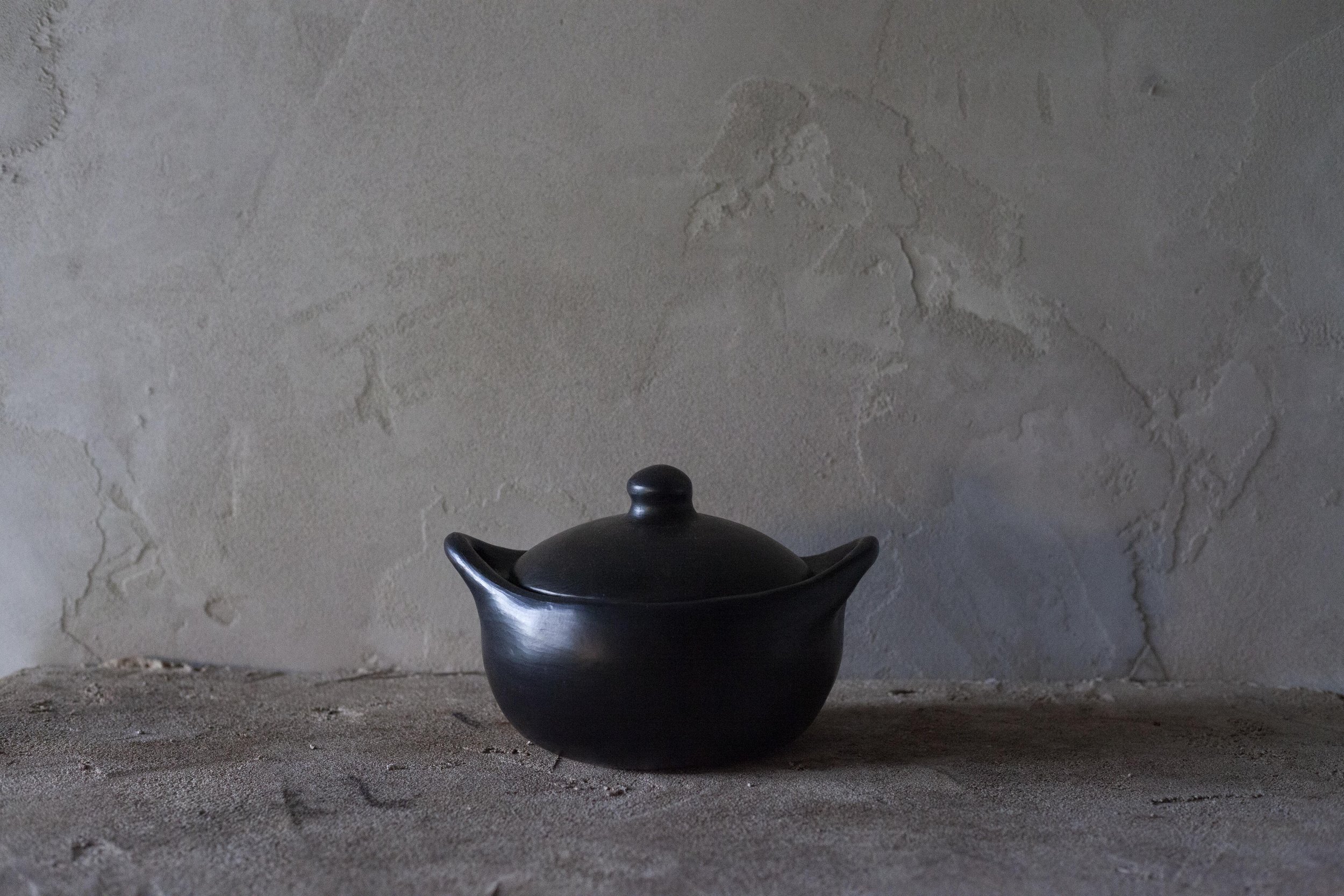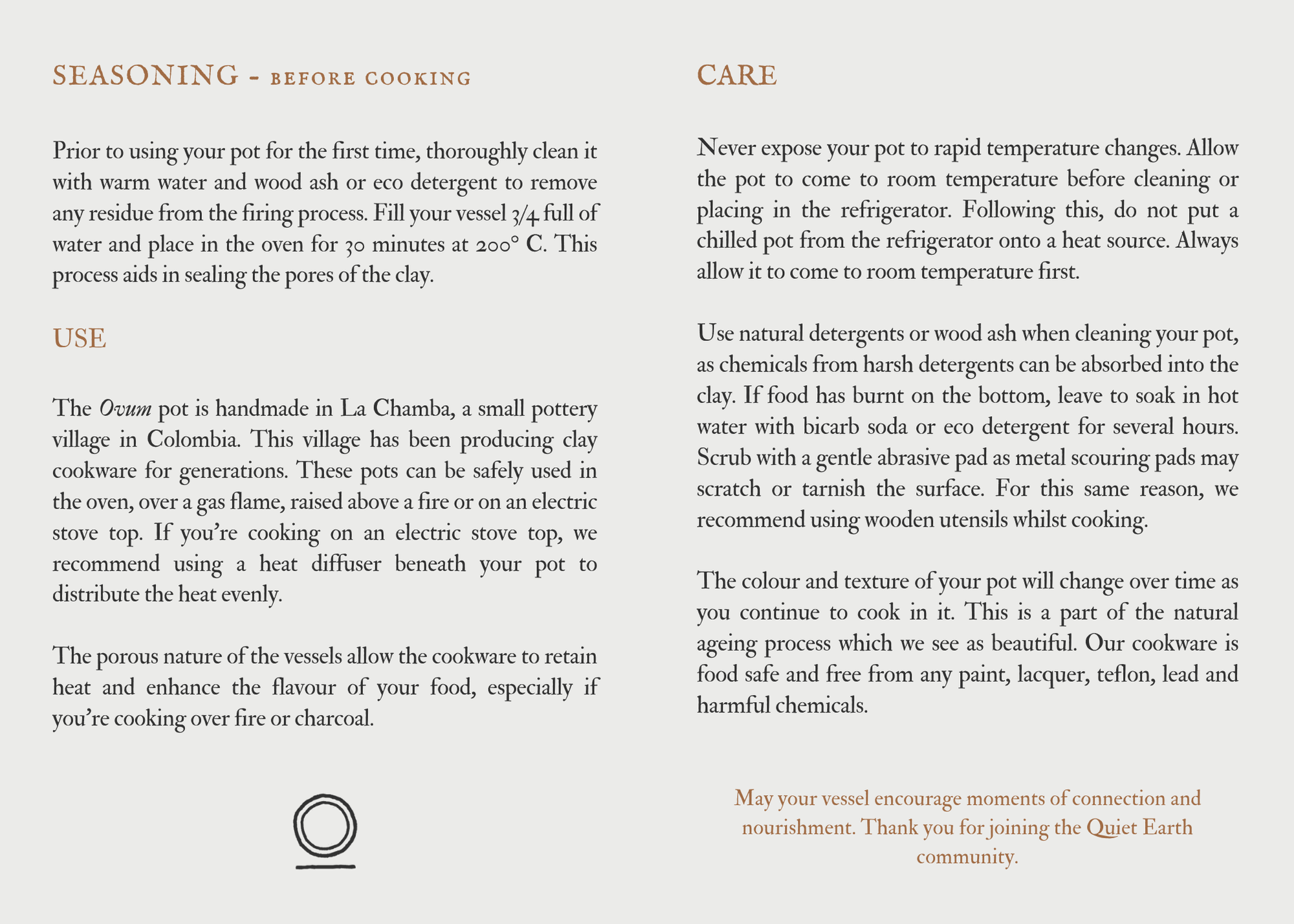 Image 1 of 9
Image 1 of 9

 Image 2 of 9
Image 2 of 9

 Image 3 of 9
Image 3 of 9

 Image 4 of 9
Image 4 of 9

 Image 5 of 9
Image 5 of 9

 Image 6 of 9
Image 6 of 9

 Image 7 of 9
Image 7 of 9

 Image 8 of 9
Image 8 of 9

 Image 9 of 9
Image 9 of 9










Ovum - Clay Pot
These pots are handmade in a small village called La Chamba in the Andes of Colombia. The origin of this cookware can be traced back over 700 years to vases and pitchers found in archeological sites.
They are a delight to cook with. I believe cooking in clay pots makes your food taste better, especially if you’re cooking on charcoal or fire as a smoky flavour will permeate through the clay into the food.
The process of making these pots has been passed down many generations from mother to daughter. The local clay of the area is harvested and mixed with sand and water. Each piece is then moulded, trimmed and smoothed by hand. The vessels are coated in a clay glaze and then left to dry in the sun.
After drying, the surface of the pots are rubbed and polished by hand using local stones which gives the pots their natural patina and sheen. They are then placed in large earthenware vessels and fired in kilns. The firing process turns the pots from terracotta to black.
As these products are handmade, each piece is unique and may vary slightly from the photograph.
NOTE - hairline cracks may form on the bottom of your pot after several uses. This is normal and will not affect your cooking or the strength of the pot. Some other clay pots contain chemicals to prevent this, though our pots are 100% pure clay. If your pot is leaking, please contact us for support.
These pots are handmade in a small village called La Chamba in the Andes of Colombia. The origin of this cookware can be traced back over 700 years to vases and pitchers found in archeological sites.
They are a delight to cook with. I believe cooking in clay pots makes your food taste better, especially if you’re cooking on charcoal or fire as a smoky flavour will permeate through the clay into the food.
The process of making these pots has been passed down many generations from mother to daughter. The local clay of the area is harvested and mixed with sand and water. Each piece is then moulded, trimmed and smoothed by hand. The vessels are coated in a clay glaze and then left to dry in the sun.
After drying, the surface of the pots are rubbed and polished by hand using local stones which gives the pots their natural patina and sheen. They are then placed in large earthenware vessels and fired in kilns. The firing process turns the pots from terracotta to black.
As these products are handmade, each piece is unique and may vary slightly from the photograph.
NOTE - hairline cracks may form on the bottom of your pot after several uses. This is normal and will not affect your cooking or the strength of the pot. Some other clay pots contain chemicals to prevent this, though our pots are 100% pure clay. If your pot is leaking, please contact us for support.
These pots are handmade in a small village called La Chamba in the Andes of Colombia. The origin of this cookware can be traced back over 700 years to vases and pitchers found in archeological sites.
They are a delight to cook with. I believe cooking in clay pots makes your food taste better, especially if you’re cooking on charcoal or fire as a smoky flavour will permeate through the clay into the food.
The process of making these pots has been passed down many generations from mother to daughter. The local clay of the area is harvested and mixed with sand and water. Each piece is then moulded, trimmed and smoothed by hand. The vessels are coated in a clay glaze and then left to dry in the sun.
After drying, the surface of the pots are rubbed and polished by hand using local stones which gives the pots their natural patina and sheen. They are then placed in large earthenware vessels and fired in kilns. The firing process turns the pots from terracotta to black.
As these products are handmade, each piece is unique and may vary slightly from the photograph.
NOTE - hairline cracks may form on the bottom of your pot after several uses. This is normal and will not affect your cooking or the strength of the pot. Some other clay pots contain chemicals to prevent this, though our pots are 100% pure clay. If your pot is leaking, please contact us for support.


Inside the pottery village of La Chamba, Colombia. Photo taken in 1975 by Richard Cross.

Clay pots drying in the sun before firing.
Learn more about how and where our OVUM pots are made here:










